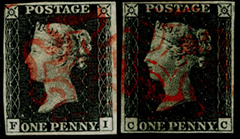 First Issues Collectors Club
of stamps and philatelic material
First Issues Collectors Club
of stamps and philatelic material
Home - Catalog - Categories - Index - Journal - Exhibits - Auctions - Forgeries - Join
 First Issues Collectors Club
of stamps and philatelic material
First Issues Collectors Club
of stamps and philatelic material
Home - Catalog - Categories - Index - Journal - Exhibits - Auctions - Forgeries - Join
| first issues > countries > japan |
| Asia | 4 |
Imperforate, native laid paper, no watermark, engraved.
Issued without gum. Denomination printed in black.
Printed by Matsuda, Kyoto.
| Description | # printed | # issued | Scott # | SG# † | Mi# | Y&T# ‡ | Notes |
|---|---|---|---|---|---|---|---|
48 mon brown |
? | 400,000 total for all values | 1 | 1, 2 | 1 | ||
100 mon blue |
2 | 3, 4 | 2 | ||||
200 mon vermilion |
3 | 5, 6 | 3 | ||||
500 mon blue green |
4 | 7, 8 | 4 | shades |
All issue quantities are approximate.
† Gibbons distinguishes between several colour and/or printing varieties in each of the first issues.
‡ Y&T has an A/B plate variant for each value and a colour varient for the 500m.
The stamps were printed using two plates for the Dragon and one plate for each value. Each plate is made up of 40 slightly different, individually engraved, images.
The issue date was taken from the Scott catalog. Other authorities have used Wednesday March 1, 1871.
The first issue was printed until February 1872 and remained valid until November 30, 1889.
Counterfeits are plentiful, but according to Frank Aretz's book "Know Your Stamps" about 90% of the genuine stamps have a secret printers mark in the lower left. The reason it is not 100% may be related to the fact that all stamps on a plate of 40 were engraved individually.
The secret printers mark.
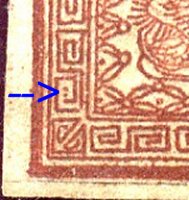 |
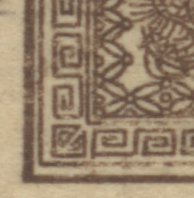 |
Genuine |
Forgery |
A few of the characteristics distinguishing genuine stamps from forgeries are:
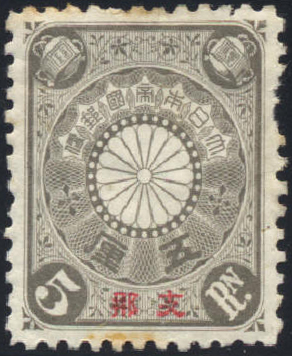 |
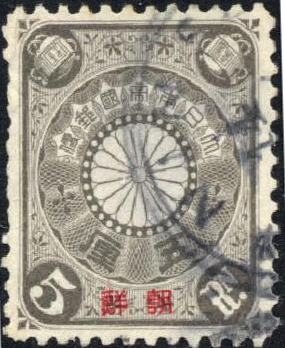 |
Offices in China |
Offices in Korea |
| 1900 Sc SG1 | 1900 Sc SG |
Japanese Offices Abroad
China - an office was opened in Shanghai in 1876 followed by agencies elsewhere. They used unoverprinted Japanese stamps until 1900, then three main sets of overprints (with subsequent variants) issued in 1900, 1913 and 1914.
Korea - similarly, an office was opened at Pusan in 1876 and others later using unoverprinted stamps. Korean and Chinese were in use, valued at par and the overprints were introduced in 1900 to prevent speculation.
Sources: ScC, SGP18, YTC.
Images from Japan Philatelic, NickB.
| Page created 19 Feb 2014 | Page updated 28-Nov-2020 |